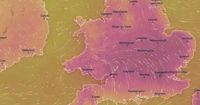The United Kingdom is bracing itself for yet another bout of extreme weather as the fourth heatwave of 2025 takes hold, promising soaring temperatures, water shortages, and a stark north-south divide in weather conditions. This latest spell of hot weather, forecast to peak between August 11 and August 13, comes on the heels of a turbulent summer already marked by three previous heatwaves, disruptive storms, and mounting environmental concerns.
According to the Met Office, the heatwave is expected to intensify as the remnants of Tropical Storm Dexter sweep across the country, drawing a surge of warm air from the southwest. Temperatures are predicted to climb steadily through the weekend, with the mercury reaching 27°C in parts of southern England before spiking above 30°C on Monday and Tuesday. In isolated areas, particularly in the southeast, forecasters have warned that temperatures could even hit the mid-30s Celsius by Tuesday, August 12, with some models suggesting highs as great as 34°C (BBC, LBC, and The Scottish Sun).
"We're confident that temperatures will increase markedly by the start of next week, reaching the low 30s Celsius in parts of England on Monday and perhaps the mid-30s in a few places on Tuesday," said Steven Keates, Deputy Chief Meteorologist at the Met Office, as quoted by multiple news outlets. However, Keates cautioned that "the length of this warm spell is still uncertain, and it is possible that high temperatures could persist further into next week, particularly in the south."
The UK Health Security Agency (UKHSA) has responded by issuing a yellow heat health alert for large swathes of the country, including Yorkshire and the Humber, the East Midlands, the East of England, the South East, and the South West. The alert is in effect from midday on Monday, August 11, until 6pm on Wednesday, August 13, warning of "significant impacts" on health and social care services. The agency has urged the public, particularly vulnerable groups, to take precautions as the heatwave unfolds (LBC, BBC).
Weather maps and forecasts suggest that nine major UK cities—London, Manchester, Liverpool, Birmingham, Bristol, Swansea, Nottingham, Leeds, and Norwich—could see temperatures reach 32°C by Tuesday afternoon, turning the maps a dramatic shade of red as the heat peaks. Other cities, such as Brighton and Newcastle, will experience slightly milder conditions, with highs around 23°C. The warm spell is expected to continue until at least Thursday in some eastern regions, though the Met Office notes that the duration and northern spread of the heat remain uncertain (Daily Express, BBC).
While southern and central England prepare for the sweltering conditions, the story is starkly different in Scotland, Northern Ireland, and parts of the north. The aftermath of Storm Floris earlier in the week left more than 32,000 people in Scotland and the North East of England without power, with winds topping 124mph in the Highlands and widespread travel disruption (LBC, The Scottish Sun). Now, as Tropical Storm Dexter approaches, Scotland is set to miss out on the heatwave almost entirely. Instead, a low-pressure system will bring spells of rain and showers from the Atlantic, particularly on Wednesday and Thursday, just as most pupils return to school after the summer break. Despite the rain, temperatures in Scotland will remain warm, reaching up to 23°C by midweek (The Scottish Sun).
Yet, even this rainfall is proving to be a double-edged sword for Scotland. The Scottish Environment Protection Agency (SEPA) reports that, despite torrential downpours in July and during Storm Floris, the rain has largely failed to replenish groundwater supplies. "The longer-term picture, particularly in the east, remains one of sustained pressure on our water environment. July’s rain came too quickly to do much good. What we need is steady, sustained rainfall to allow the environment to recover, not short bursts that run straight off dry ground," explained Claire Tunaley, SEPA Senior Hydrologist. Several river catchments, including the Deveron, Ythan, Don, Esk, Firth of Tay, and Tyne, remain at 'moderate' water scarcity, with Fife recording its lowest ever July groundwater levels (The Scottish Sun).
Meanwhile, the south of England faces its own water crisis. On August 9, South East Water warned customers in Sussex that reservoirs are "falling quicker and earlier than usual," with the Ardingly and Arlington reservoirs at their lowest levels for this time of year since the 2022 drought. The company has imposed a hosepipe ban in Sussex and Kent, and is closely monitoring supplies in Surrey, Hampshire, and Berkshire, with the possibility of further restrictions looming. More than 8.5 million UK households are currently affected by hosepipe bans, as water companies scramble to preserve dwindling resources (BBC).
"Most of the water in them is taken from the nearby rivers, whose flow is much lower than normal because of multiple heatwaves. The reservoirs have not been this low at this time of year since the drought of 2022 and, with more warm weather due very soon, we’re asking people to protect resources and keep water use around the home to essential purposes only—namely drinking, washing and cooking," a spokesperson for South East Water said (BBC).
The heatwave’s arrival is being driven by a combination of factors. High pressure anchored in the south is drawing in warmer air from mainland Europe, where temperatures are also running high for the season. This setup, combined with the influence of Tropical Storm Dexter, is leading to what the Met Office describes as "day-on-day heating" across southern parts of the UK. While the southeast is expected to see the highest temperatures, the influx of hot air could also trigger instability, bringing the risk of heavy, possibly thundery showers across southern areas on Monday and Tuesday. These showers are expected to be "hit-and-miss in nature but could bring brief downpours and gusty winds," according to the Met Office. Northern areas, meanwhile, are likely to remain closer to seasonal averages, with temperatures in the high teens or low 20s Celsius (BBC, LBC).
For a heatwave to be officially declared in the UK, a location must record at least three consecutive days of daily maximum temperatures meeting or exceeding the region’s heatwave threshold—ranging from 25°C in Scotland to 28°C in London. With the current forecasts, many areas in central, southern, and eastern England are expected to meet these criteria, solidifying the fourth heatwave of an already exceptional summer (BBC, Daily Express).
As the UK enters another period of extreme weather, the impacts are being felt across the board—from water scarcity and environmental pressures to public health alerts and travel disruptions. The contrasting experiences of the north and south highlight the country’s growing vulnerability to climate extremes, with experts and officials alike calling for both immediate caution and longer-term adaptation.
With the heatwave set to peak early next week and uncertainty lingering about how long the hot spell will last, millions across the UK are watching the skies—and their water meters—closely.





